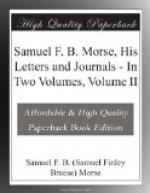“Alfred Vail, then a student in the university, and a young man of great ingenuity, having heard of my invention, came to my rooms and I explained it to him, and from that moment he has taken the deepest interest in the Telegraph. Finding that I was unable to command the means to bring my invention properly before the public, and believing that he could command those means through his father and brother, he expressed the belief to me, and I at once made such an arrangement with him as to procure the pecuniary means and the skill of these gentlemen. It is to their joint liberality, but especially to the attention, and skill, and faith in the final success of the enterprise maintained by Alfred Vail, that is due the success of my endeavors to bring the Telegraph at that time creditably before the public.”
The idea of telegraphs seems to have been in the air in the year 1837, for the House of Representatives had passed a resolution on the 3d of February, 1887, requesting the Secretary of the Treasury, Hon. Levi Woodbury, to report to the House upon the propriety of establishing a system of telegraphs for the United States. The term “telegraph” in those days included semaphores and other visual appliances, and, in fact, anything by which intelligence could be transmitted to a distance.
The Secretary issued a circular to “Collectors of Customs, Commanders of Revenue Cutters, and other Persons,” requesting information. Morse received one of these circulars, and in reply sent a long account of his invention. But so hard to convince were the good people of that day, and so skeptical and even flippant were most of the members of Congress that six long years were to elapse, years filled with struggles, discouragements, and heart-breaking disappointments, before the victory was won.
Morse had still to contend with occasional fits of illness, for he writes to his brother Sidney from Morristown on November 8, 1837:—
“You will perhaps be surprised to learn that I came out here to be sick. I caught a severe cold the day I left New York from the sudden change of temperature, and was taken down the next morning with one of my bilious attacks, which, under other treatment and circumstances, might have resulted seriously. But, through a kind Providence, I have been thrown among most attentive, and kind, and skilful friends, who have treated me more like one of their own children than like a stranger. Mrs. Vail has been a perfect mother to me; our good Nancy Shepard can alone compare with her. Through her nursing and constant attention I am now able to leave my room and have been downstairs to-day, and hope to be out in a few days. This sickness will, of course, detain me a while longer than I intended, for I must finish the portraits before I return.”
This refers to portraits of various members of the Vail family which he had undertaken to execute while he was in Morristown. Farther on in the letter he says:—




